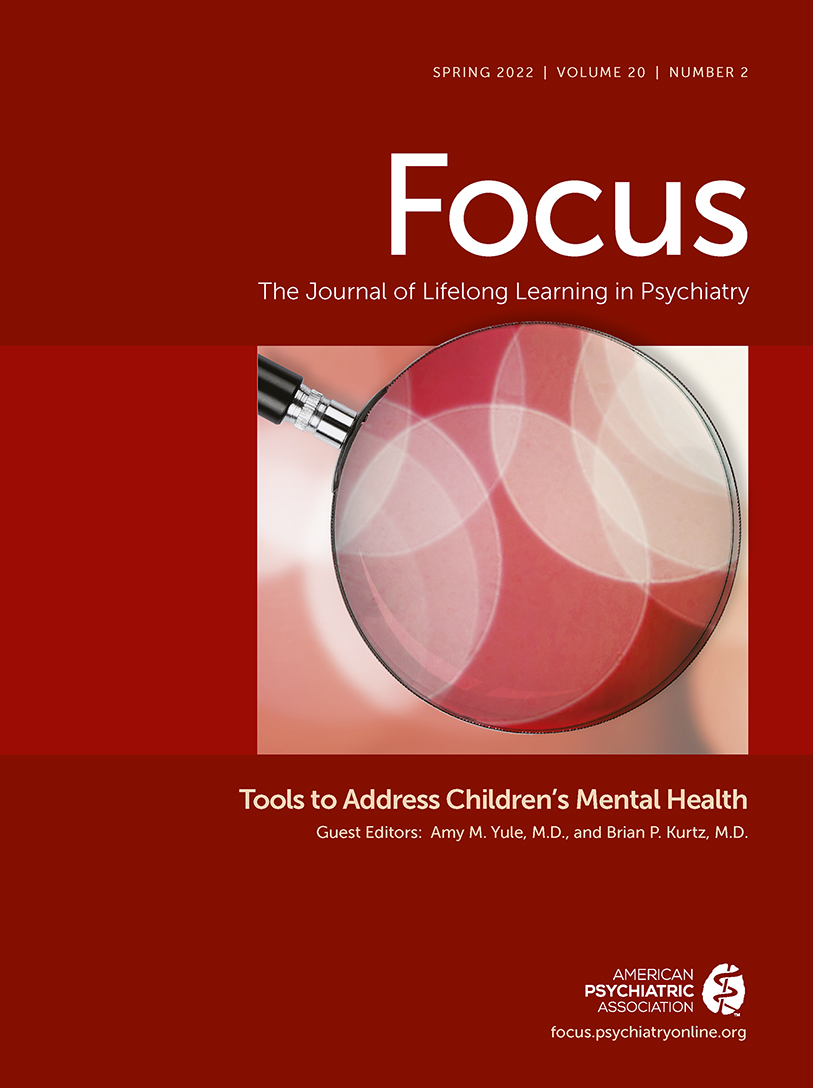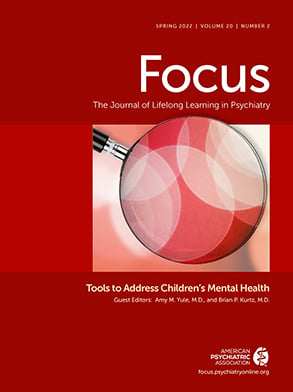Psychosocial Interventions
Trauma-focused therapies result in improved outcomes for children with traumatic stress when compared with both waitlist and active controls (
34). Evidence-based, trauma-focused therapies have several components that are similar across interventions. These components include psychoeducation on how children and adolescents may continue to be bothered by the traumatic event(s), including the core components of PTSD, even when they are safe; the use of coping skills or other techniques to empower the child or adolescent to decrease symptoms when distressed or traumatic memories are triggered; the opportunity for either gradual exposure and/or cognitive processing to decrease the frequency and intensity of future trauma-associated reactions; and guidance around improved safety both during and after therapy.
One of the most well-studied and widely available of the evidence-based, trauma-focused treatments is TF-CBT (
35). Originally designed for treating survivors of sexual abuse, TF-CBT has over 20 randomized controlled trials (RCTs) demonstrating efficacy among populations who have experienced a wide variety of traumatic events (
29). Furthermore, although individual in-person outpatient therapy is the most studied and widely available form of TF-CBT, adaptations have been developed for school, group, and virtual settings. Furthermore, TF-CBT developers have created approaches within TF-CBT to address unique populations who have experienced loss as well as youths who identify as LGBTQ+ (lesbian, gay, bisexual, transgender, and queer or questioning, plus other identities). TF-CBT is a manualized approach with significant interaction and involvement with caregivers throughout treatment. TF-CBT can generally be delivered over 16–24 weeks in the outpatient setting, with complex trauma cases potentially requiring additional sessions. In TF-CBT, the approach for exposure and cognitive processing of the trauma is the trauma narrative, a developmentally sensitive method for allowing the child or adolescent to write his or her own story, including the use of dictation or drawings for children who are too young to write. It is important to note that the trauma narrative includes key aspects of the child that are not limited to or defined by the trauma itself, including chapters that are future and growth focused.
Licensed mental health professionals, including but not limited to psychiatrists, psychologists and social workers, may be trained in TF-CBT. Training generally consists of web-based modules, 2 or more full days of in-person or virtual training, and 12 months of ongoing consultation calls. Certification in TF-CBT is now also an option and can make it easier to identify community providers who have received training and worked to implement TF-CBT within their practice at a high level of fidelity to the model.
Although TF-CBT is well equipped to address trauma-associated symptoms in a diverse array of children and adolescents, predominant externalizing or unsafe behaviors may indicate the application of other treatment strategies. For example, oppositional, hyperactive, or increased-reactivity behaviors may arise in younger children, whereas risk-taking, oppositional, suicidal, and nonsuicidal self-injurious behavior may be present in teenagers. In general, when the behaviors are not severe, TF-CBT may adequately address the behaviors, improving the caregiver’s capacity to manage the behaviors at home. However, in treating children for whom these behaviors are the predominant and impairing feature, particularly where trauma reminders or other distress trigger significant and potentially unsafe episodes, alternative treatments, such as parent-child interaction therapy (PCIT) and dialectical behavioral therapy (DBT), may be considered.
PCIT is a well-disseminated, trauma-informed, evidence-based approach to improve oppositional and other problematic externalizing behaviors among young children (
36). It is primarily studied among children 3–6 years old; the therapist works with the parent to improve the parent’s capacity to follow the child’s lead during play (child-directed interaction) and improve the parent’s ability to give and follow through with effective commands (parent-directed interaction). During most sessions, the therapist is on the other side of a one-way mirror while the parent and child interact. As the parent wears an earpiece, the therapist provides direct “bug-in-ear” coaching and immediate feedback to the parent while the parent and child interact. Not only have numerous studies shown PCIT to be effective in improving externalizing behaviors, but positive studies that specifically include maltreated children have also shown both improved behaviors and decreased risk of recidivism in the child welfare system (
37,
38).
DBT, adapted for adolescents from the initially derived model for adults, is a trauma-informed therapy with evidence for efficacy within externalizing and behavioral symptoms within maltreated and otherwise trauma-exposed individuals (
39). DBT, which includes both individual sessions and group sessions, has been demonstrated to be effective in reducing unsafe behaviors in adults and adolescents with risk-taking, self-injurious behaviors, and PTSD. In the adolescent adaptation, group sessions often include parent-adolescent dyads in which parents learn, along with their adolescents, core DBT skills and are also coached on how to help support their adolescents’ safety and improve communication.
Pharmacologic Approaches
It is challenging to apply an evidence-based pharmacologic approach to children with a history of maltreatment whose main symptoms and functional challenges are related to traumatic stress, even if they meet full criteria for PTSD. The adult literature, primarily in depression, demonstrates that adults with a history of childhood traumas, including maltreatment, do not respond to traditional antidepressant treatment as well as adults without such a history (
40,
41). Within the child literature, most studies on common childhood mental health conditions such as anxiety, depression, and ADHD rarely include details on the impact of maltreatment experiences on medication efficacy. From an epidemiologic standpoint, the populations with the highest (and likely least efficacious) pharmacotherapy burden include youths in foster care. Furthermore, there are limited studies on the treatment of PTSD in children, with only two RCTs of sertraline, both negative (
42,
43). Therefore, it is relatively common practice for providers, when aware of a child or adolescent’s history of trauma-associated maltreatment, to acknowledge the trauma, as well as any possible traumatic stress, and then move forward with diagnosing a concurrent (and presumed to be unrelated) comorbid psychiatric disorder amenable to pharmacotherapy, even when the observed symptoms might be better explained by syndromic overlap with traumatic stress rather than true comorbidity (
4).
In the past several years, the American Academy of Pediatrics and the American Academy of Child and Adolescent Psychiatry have begun to advocate for a trauma-informed approach to the pharmacologic treatment of children with a history of child maltreatment. Recent clinical reports highlight that a staged approach may be beneficial for children with a history of child maltreatment–associated trauma and current traumatic stress (
4,
44). In the first phase of a staged approach, recommendations include ensuring that the patient receives evidence-based trauma therapy. Additionally, when sleep difficulties are present, a trauma-informed approach to sleep should be considered. This would include trauma-informed psychoeducation with specific strategies for identifying and addressing trauma reminders at night, improved overall sleep hygiene and routine, and consideration of a short-term trial of a medication (
45). In children with PTSD, clinical guidelines recommend trials of melatonin as well as adrenergic modulating agents such as prazosin and clonidine (
45).
In a second phase of treatment, with consistent and improved sleep and an adequate number of sessions of evidence-based trauma treatment, reevaluation of common childhood disorders such as depression, anxiety, and ADHD are more readily separated from traumatic stress or chronic insomnia. However, for many youths with histories of child maltreatment, even challenges that are identified as existing before the index maltreatment are often related to previous traumas or adversities that can only be uncovered with careful questioning.
Regardless, it is helpful to remember that individuals with a history of trauma are at increased risk of not responding to pharmacologic medication, even when indicated by the presence of a comorbid condition that is typically amenable to treatment. In addition, these individuals are at increased risk of adverse effects of medication and are more likely to be treated with complex pharmacotherapy (
44). Therefore, pharmacologic approaches that are conservative, intentionally limit complexity, and discontinue rather than augment when initial approaches are unsuccessful are consistent with trauma-informed practice. There is no evidence to strongly support the use of second-generation antipsychotics, other mood stabilizers, benzodiazepines, or the concurrent use of multiple adrenergic modulating agents among maltreated children whose impairment is primarily driven by traumatic stress (
44).
Deprescribing
As discussed earlier, the diversity and severity of symptoms in maltreated youths may push care providers to trial treatment strategies that lead to considerable polypharmacy. A recent retrospective evaluation of 1,700 children on Medicaid or in foster care in the State of Kentucky found that 16%–34% had “high-level psychotropic polypharmacy,” defined as taking at least four psychotropic medications for a duration of at least 30 days (
46). This study also found that 92%–99% of children with high-level polypharmacy were diagnosed with “disruptive behavior disorders,” among other comorbid diagnoses. This diagnostic category was composed of ADHD, oppositional defiant disorder, and conduct disorder diagnoses—which have each been associated, or hypothesized to be misdiagnosed for, traumatic stress (
47–
49)—and was associated with a longer duration of polypharmacy treatment (
46). Although these data represent only a single state’s situation, it is not a singular experience, with general patterns being appreciated of elevated prescribing within groups known to have been exposed to childhood maltreatment or who are at high risk for traumatic stress (
4).
Such prescribing practices have been increasingly discussed in the literature, with a desire to better understand the underlying pressures directing these practices and the development of strategies to effectively and safely deprescribe, when possible. A recent evaluation of physician perspectives (
50), direction from a 2009 guideline published by the American Academy of Child and Adolescent Psychiatry (
51), and other recent evaluations of problematic prescribing practices (
4,
52) provide important insights and direction on implementing an effective deprescribing strategy. In evaluating these guidelines, it is important to focus on the needs of each individual and understand that the goal is not, necessarily, to discontinue all medications but to thoughtfully prioritize and reduce dosing or discontinue medications of limited efficacy or particularly high risk to the patient. It is also critical to consider the context of the currently prescribed regimen, barriers to access of alternative treatment strategies, and the perspective of the patient along with all other invested parties. For a summary of existing guidelines and these other considerations, see
Box 2.
For children and adolescents who have experienced maltreatment and other co-occurring traumas, each patient and social situation is unique and must be factored into plans for deprescribing. In addition, careful consideration must be given regarding when to refer to a child and adolescent psychiatrist, particularly when treatment regimens or requests from stakeholders fall outside the bounds of safe practice for the given provider. Unfortunately, access to child and adolescent psychiatry providers is extremely limited in many areas and is not always a feasible option, requiring careful consideration of appropriate practices.

